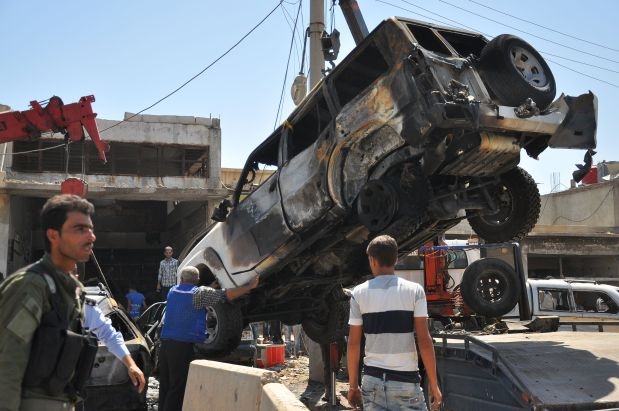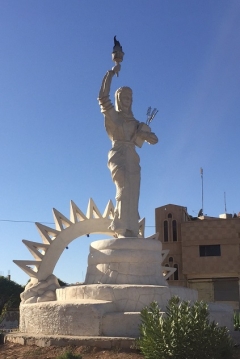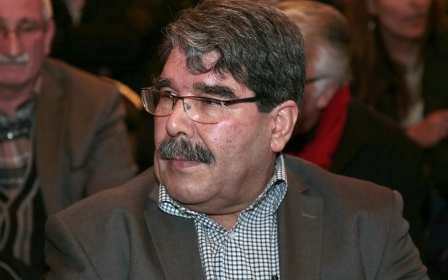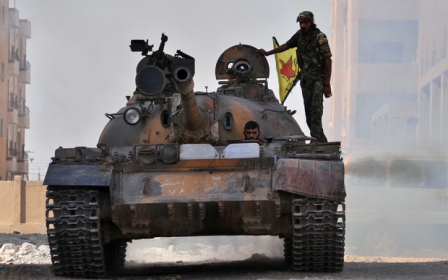In Qamishli, a new dawn for Syrian Kurds
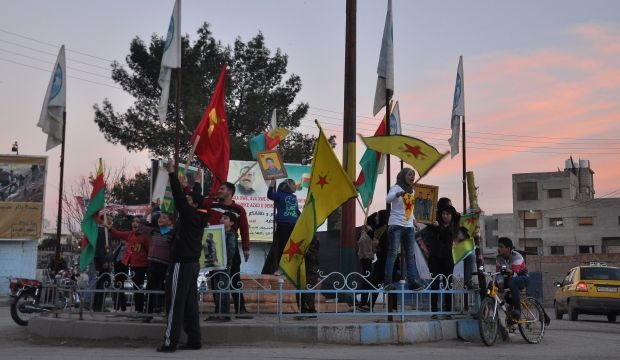
QAMISHLI, Syria - It’s strange at first sight to find a statue of Hafez al Assad, Syria’s former strongman, firmly ensconced in the centre of a roundabout in this Kurdish city, the capital of an autonomous Kurdish-run quasi-state which has emerged from Syria’s civil war. Similar symbols have been torn down by angry crowds in most Syrian towns and cities from which the government’s combat divisions have retreated.
Equally unexpected is the display of two large photographs of Hafez’s son, Bashar al Assad, the current president, in the window of the local branch of Syrianair. Nearby, a policeman in the peaked cap and neat white shirt uniform that are familiar from central Damascus, directs hooting traffic through the crowded bazaar area during the rush before this week’s Eid al-Adha festival.
In spite of the apparent oddity, the continuation of Assad government symbols has a comprehensible logic in the complicated jungle of Syria’s war. The government-held quarter in Qamishli amounts to little more than a few blocks, a small city-centre garrison hiding behind heavy fortifications, the airport and a road which connects them.
In return for the Syrian army’s departure, the Kurdish leaders of the Democratic Union Party (PYD) who run a 400-kilometre-wide swath of territory south of the Turkish border are free to consolidate their power. The Kurds are leery of Turkish intervention as well as of Islamic State (IS) fighters. Not having to worry about the Syrian army means facing one enemy less.
Islamic State and other opposition forces sometimes accuse the PYD of being allies of Assad. They wonder why the PYD and its armed forces do not overrun the Qamishli garrison and seize the airport. “War is a matter of strategy and tactics. You can’t fight on too many fronts,” Lawand Rojava, a YPG commander and its head of foreign relations in Hasaka, a town 60km south of Qamishli, told MEE. Hasaka is also divided between a small government-run district and a larger Kurdish-run area.
“The regime has aircraft and uses barrel bombs. Why should we risk our people’s lives by attacking the regime’s base, just to prove to the world that we are not allies of the regime? We have to think about the interests of the people. The regime also thinks strategically. We have had many clashes with the regime but they’re not attacking us now,” he added.
Hasaka is under threat, but from IS. Raqqa, the IS capital, is only three hours’ drive away. IS miltants attacked the town in June and it cost 50 Kurdish soldiers’ lives to drive them out after two weeks. The dead included combat troops of the YPJ, the women’s section of the Syrian Kurdish forces. Like other towns in Rojava, as the Kurds call their statelet, public buildings and checkpoints on the roads in Hasaka are covered with posters of young men and women “martyrs”, the usual term for troops who died in the war.
The IS attack in June initially targeted the town’s southern district which the Assad forces control. At the time, some foreign media reports suggested the YPG fought alongside the Syrian army to repel IS, but Lawand Rojava and other YPG sources insist this was not the case.
“Through Arab tribal leaders, the regime asked for help against Daesh but we refused. We said to them ‘Both of you are illegal’,” he said. The YPG only intervened when militants penetrated the Kurdish section after more than a week of fighting Syrian government troops. At that point, the US came in with airstrikes. “The Americans didn’t use airstrikes when Daesh was fighting the regime. The regime and Daesh fought alone for 10 days,” Rojava said.
He was scathing about the government forces, calling them ill-disciplined, poorly motivated, and prone to flee. They included various militias from the ruling Baath party, as well as Arab tribal militias and the National Defence Forces (NDF), a network of volunteers and reservists who were mobilised two years ago by Assad’s army to make up for the dwindling pool of conscripts. The border line between these forces and IS was blurred, Rojava said, “Many regime units turned into Daesh when Daesh arrived. There are also many Da’esh spies inside the regime forces,” he added.
Evidence that Syria’s Kurds are not Assad collaborators or eager to see Assad’s rule return is not confined to statements from Kurdish leaders. No visitor to the region can fail to be struck by people’s pride in their independence from Damascus and the benefits their new status has provided. The new national flag as well as banners displaying the YPG star flutter everywhere. Above all, Kurds are free to use their language known as Kurmanji publicly without fear.
When the 2011 uprising took hold, Assad gave citizenship to hundreds of thousands of the estimated two million Syrian Kurds who for various reasons had been denied it. The concession was a classic example of “too little, too late”.
The suppression of Kurdish culture throughout Syria began long before the Assads. It still smarts, like an unhealed wound, for many people. Hisham Arafat, who teaches English in a secondary school, studied at the University of Latakia in the region of Syria from where the Alawite minority comes. The Assads are Alawites.
“Arab students couldn’t understand there were Kurds in Syria. They’d ask me what country I was from. When I said ‘I’m Syrian’, they’d be confused. ‘There are no Kurds in Syria’, they would say. It was insulting and hard to forget,” he told MEE.
Ahmad Bave Alan edits Buyer, a fortnightly newspaper in Qamishli which started last May and has six pages of text in Kurmanji and six in Arabic. Arabs only form five percent of the city’s population, and the Arabic text is mainly designed for the hundreds of Kurds who are more fluent in Arabic than Kurmanji because they were denied its use for most of their lives.
Asked about the Hafez al-Assad statue which stands a hundred yards from his office, Alan laughed. “After all the development of the last few years, one statue is not a big deal,” he said. He points out that a Kurdish uprising against Bashar al-Assad briefly erupted as far back as 2004 when crowds toppled a statue of Hafez al-Assad in Amuda. The Syrian police reacted fiercely. Amuda, where I am staying, now sports a rather kitschy variant of a woman carrying the torch of liberty in place of the dead dictator. The place has been re-named Free Woman Square. So, on the statue front, Syria’s Kurds have nothing to be ashamed of politically, if not aesthetically.
There are more important issues than worrying about the Hafez Assad statue in Qamishli. “It isn’t the regime that is threatening us. It’s Daesh. Our priority is defeating Daesh,” Alan said.
Middle East Eye propose une couverture et une analyse indépendantes et incomparables du Moyen-Orient, de l’Afrique du Nord et d’autres régions du monde. Pour en savoir plus sur la reprise de ce contenu et les frais qui s’appliquent, veuillez remplir ce formulaire [en anglais]. Pour en savoir plus sur MEE, cliquez ici [en anglais].



